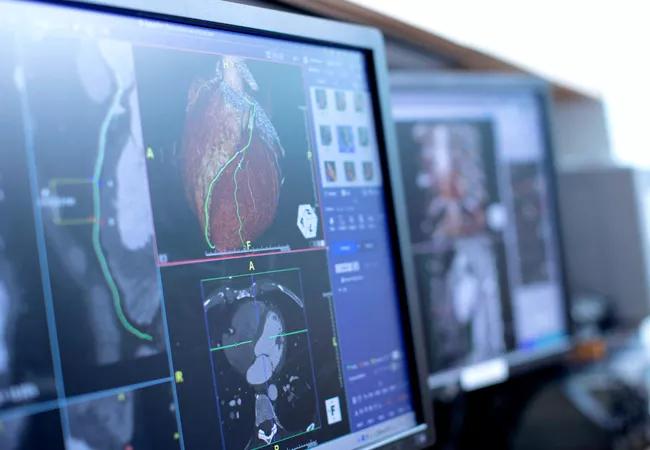When to defer imaging and what to do when you can’t

Decision-making around orders for cardiac imaging has traditionally been limited to balancing risks and benefits at the patient level, but the COVID-19 pandemic has complicated the picture. Now clinicians also must factor in the impact of potential exposure to the virus among healthcare workers, the chance that medical devices could serve as fomites and promote nosocomial spread, and the feasibility of particular imaging-guided treatment options in the specific setting of concomitant COVID-19.
Advertisement
Cleveland Clinic is a non-profit academic medical center. Advertising on our site helps support our mission. We do not endorse non-Cleveland Clinic products or services. Policy
To help cardiovascular clinicians come to grips with this changed landscape, a team of Cleveland Clinic cardiologists and other specialists has crafted a concise review, “The role of cardiac imaging in hospitalized COVID-19–positive patients,” for Cleveland Clinic Journal of Medicine’s COVID-19 Curbside Consults series.
The authors recommend that consideration of cardiac imaging for inpatients with COVID-19 be informed by four fundamental questions:
They go on to outline some general principles on the role of various imaging modalities in this setting:
Advertisement
For COVID-19 patients in whom subacute myocardial involvement is suspected, cardiac imaging is best delayed until outpatient follow-up can take place.
Much of the review is devoted to general recommendations for four important clinical scenarios in which cardiac imaging may be either useful or controversial in hospitalized patients with COVID-19.
Acute myocardial injury. The authors note that limited TTE or cPOCUS focused on ventricular dysfunction and the pattern of wall motion abnormalities may help identify the etiology and severity of acute myocardial injury and thereby determine clinical management in most cases.
Acute chest pain ± ECG changes. cPOCUS and focused TTE can elucidate valuable diagnostic and prognostic features in a COVID-19 patient experiencing an acute coronary syndrome. Particular attention should be paid to the right ventricle in view of the elevated risk of venous thromboembolism and right ventricular failure from acute respiratory distress syndrome (ARDS) in individuals with COVID-19. If symptoms are stable in patients with low or intermediate risk, imaging should be delayed in the context of medical management unless the condition progresses or becomes clinically unstable. Invasive coronary angiography and revascularization are to be considered only in cases of ST-elevation myocardial infarction; if coronary angiography is essential, left ventriculography may avoid the need for TTE.
Decompensated heart failure. Because ARDS can mimic cardiogenic pulmonary edema, discernment of decompensated heart failure can be a challenge in individuals with COVID-19. While cPOCUS/TTE should be performed in COVID-19 patients with decompensated heart failure who have no previous history of heart failure, cardiac imaging is best held off in patients with a known history of heart failure or cardiomyopathy who are presently hemodynamically stable. Other imaging modalities have no role in COVID-19 patients with acute decompensated heart failure, with the exception of cases with concomitant atrial fibrillation when restoring normal sinus rhythm is required to manage the decompensated heart failure. In such cases, cardiac CT with contrast is recommended for left atrial appendage evaluation in advance of cardioversion.
Advertisement
Suspected infective endocarditis. There are presently no literature reports of concomitant infective endocarditis and SARS-CoV-2 infection. Any potential cardiac imaging for suspected infective endocarditis in this setting should be carefully discussed with infectious disease colleagues to determine the likelihood of management changes other than extension of intravenous antibiotics. If imaging is deemed necessary and actionable, TTE is the first-line choice and requires no further investigation if it’s negative with adequate views. Further imaging in high-risk patients with typical bacteremia organisms is justified only to determine the need for surgical intervention.
“Indications for advanced cardiac imaging are limited for patients in the acute phase of COVID-19, given the risk of exposure and limited data to demonstrate significant impact on clinical management,” says review co-author Deborah Kwon, MD, Director of Cardiac MRI at Cleveland Clinic. “When advanced imaging is being considered, in-depth discussions with cardiac imaging experts are recommended to help determine if the clinical information to be obtained is worth the potential exposure risks. However, follow-up imaging in the convalescent stage may prove prognostically revealing for recovered COVID-19 patients with positive troponin or decompensated heart failure.”
“In the inpatient setting, cardiac imaging should only be ordered for patients with COVID-19 if its benefits outweigh its risks — and only if changes in acute treatment and outcomes can be anticipated,” adds co-author Brian Griffin, MD, Section Head of Cardiovascular Imaging at Cleveland Clinic. “Even then, imaging should be pursued only if no adequate alternative is available to provide the needed management guidance.”
Advertisement
The full Curbside Consult review, complete with references, is freely available here.
Advertisement
Advertisement

Patients report improved sense of smell and taste

Clinicians who are accustomed to uncertainty can do well by patients

Unique skin changes can occur after infection or vaccine

Cleveland Clinic analysis suggests that obtaining care for the virus might reveal a previously undiagnosed condition

As the pandemic evolves, rheumatologists must continue to be mindful of most vulnerable patients

Early results suggest positive outcomes from COVID-19 PrEP treatment

Could the virus have caused the condition or triggered previously undiagnosed disease?

Five categories of cutaneous abnormalities are associated with COVID-19